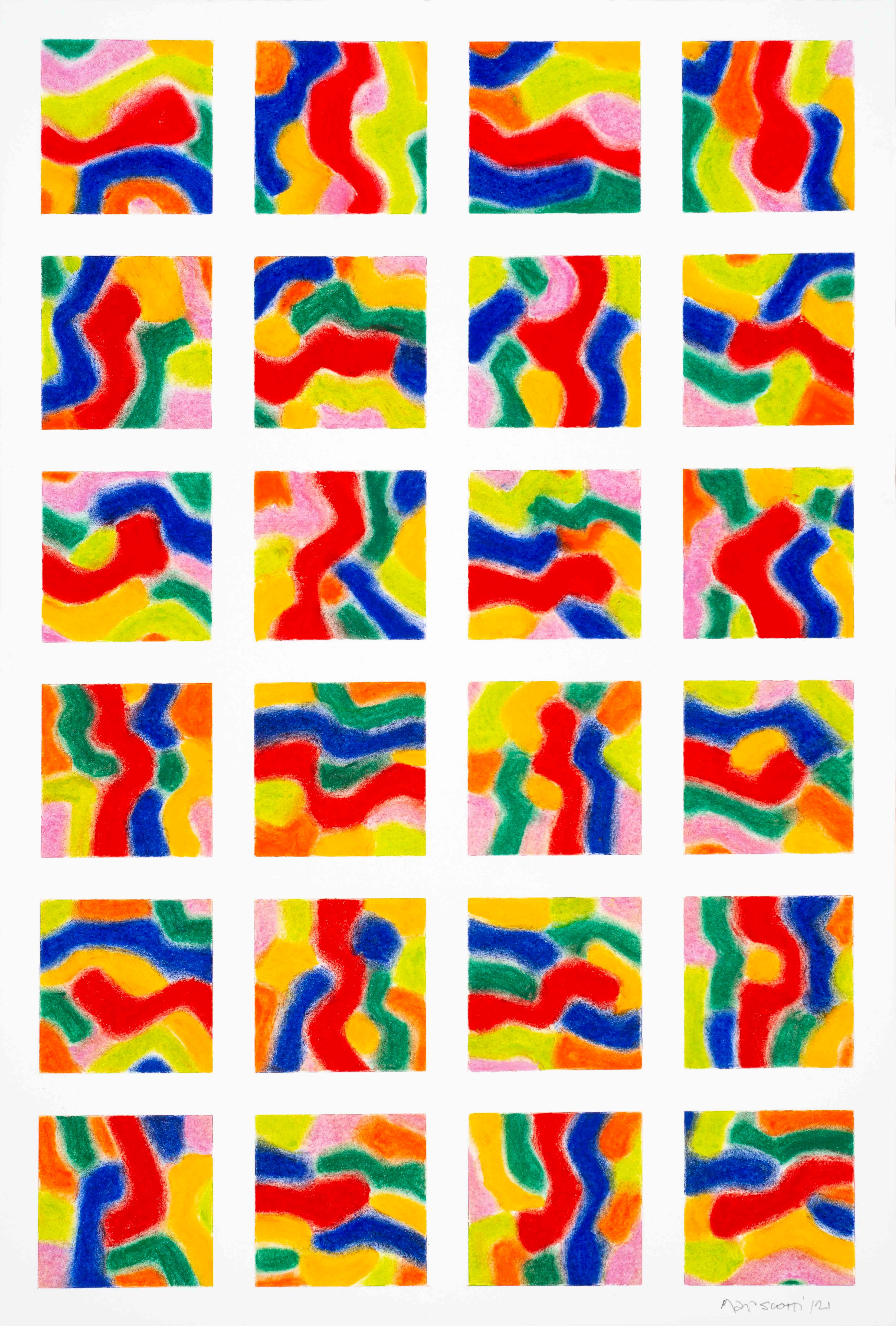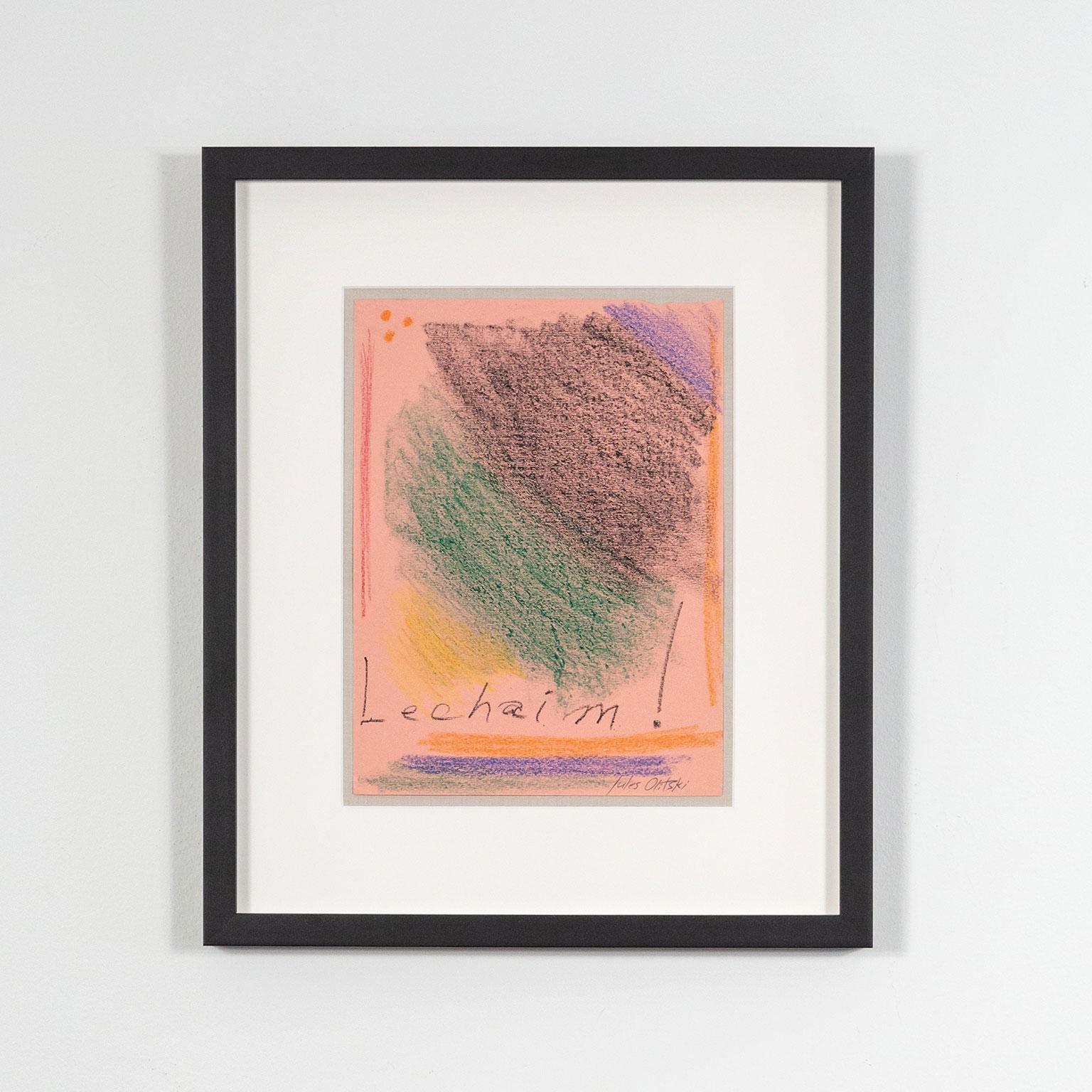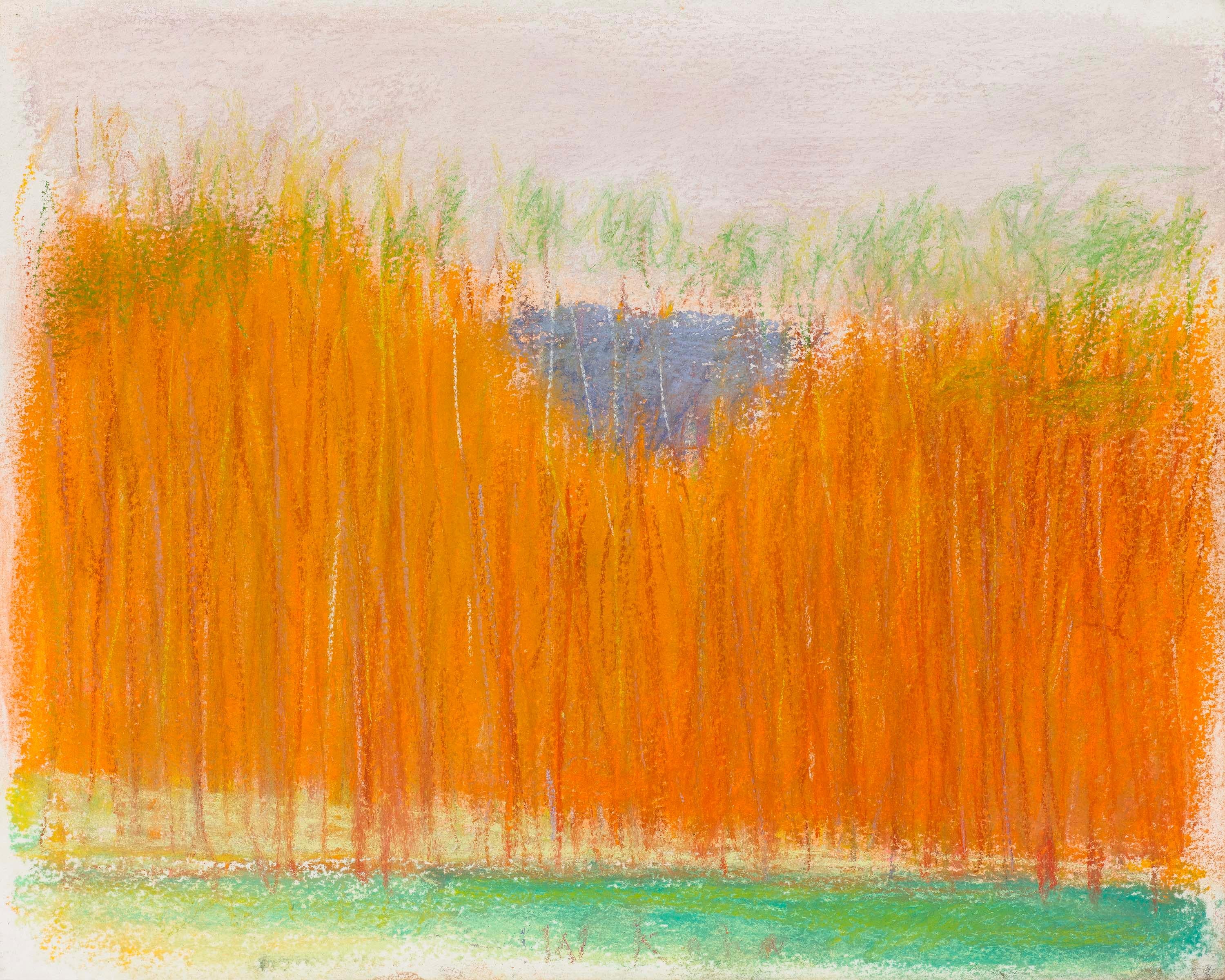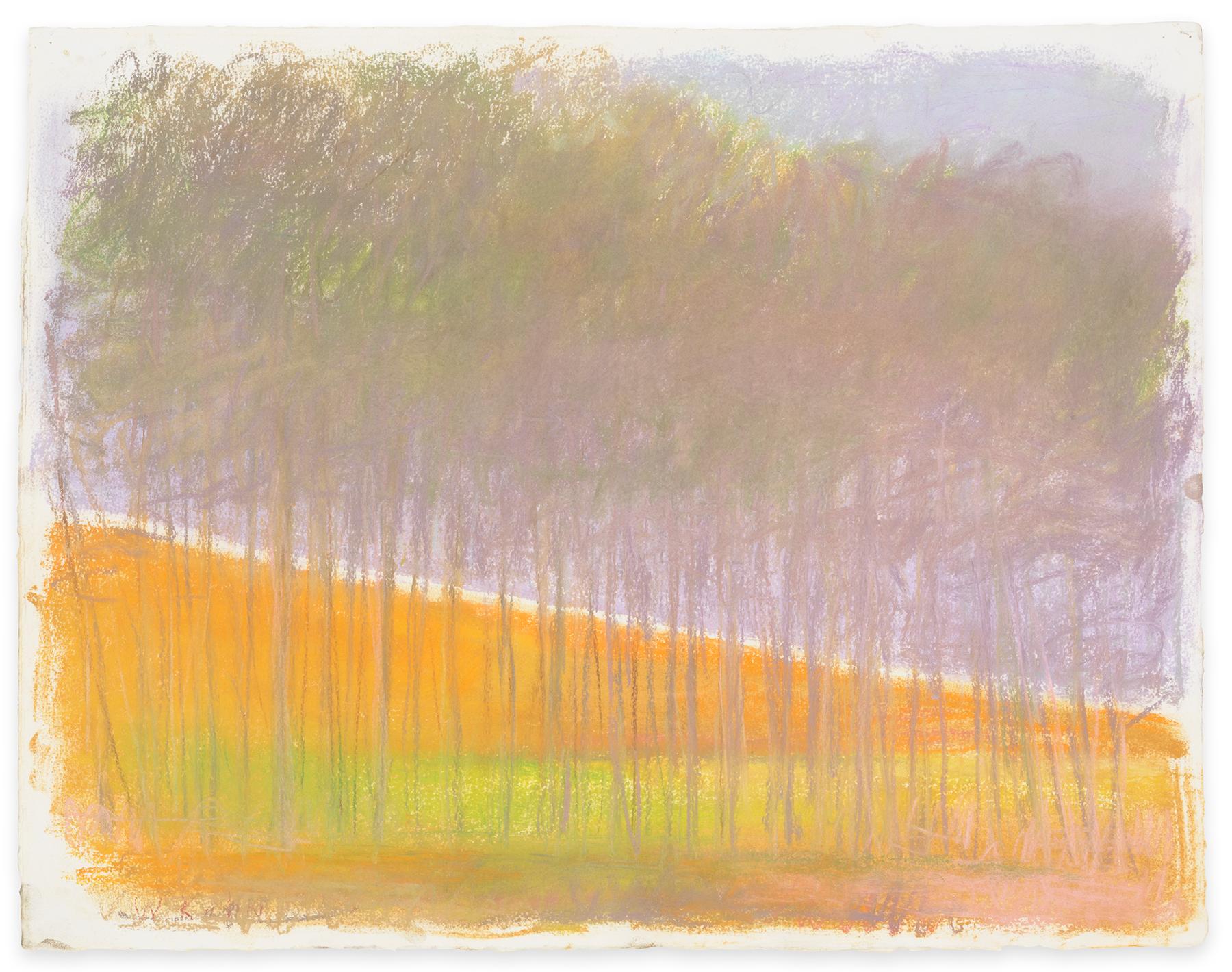Items Similar to Untitled #31, original pastel by Washington Color School and Color Field painter
Want more images or videos?
Request additional images or videos from the seller
1 of 9
Paul ReedUntitled #31, original pastel by Washington Color School and Color Field painter1982
1982
About the Item
Paul Allen Reed
Untitled #31, 1982
Oil pastel on paper
Pencil signed dated and annotated "7 10 79 1" by Paul Reed on the lower front
Frame included: This work is elegantly floated and framed in a white wood museum quality frame with UV plexiglass
Measurements:
Frame:
18 x 16 x 1.5 inches
Artwork:
11 x 9 inches
About Paul Reed:
Paul Reed was born in Washington, DC in 1919 and attended McKinley High School, where fellow artists Gene Davis and Howard Mehring were also once students. Reed moved to San Diego for college, but soon returned to DC to accept a job at The Times-Herald in 1937 working in the graphics department masking out half-tones in advertisements. At the same time, he took art courses at the Corcoran School of Art during the day. Graphic design jobs would then take Reed to Atlanta and New York before Reed established himself permanently in DC in 1952. Reed worked as a freelance graphic designer throughout the 1950s so he could have some flexibility in his schedule, regularly visiting museums and galleries with Gene Davis and painting in the mornings and evenings.
Paul Reed had his first solo exhibition at the Adams-Morgan Gallery in Washington, DC in January 1963. The stained canvases were characterized by a centralized image, often with a centrifugal motion within the jig-saw shapes. Reed had a solo exhibition at the East Hampton Gallery in New York in November of the same year. Many of the paintings exhibited in New York had a centrifugal force heightened by an accompanying small satellite painting that hung in close proximity to the main painting as if it had spun out from the central image. The suggestion of a diagonal orientation through a corner of canvas left untouched foretell the Disk paintings of 1965 where two colors corners set off a diagonal band in the center of the painting. 1964 brought solo exhibitions in DC at Jefferson Place Gallery in January and in New York at East Hampton Gallery in August. Further exhibitions were held in New York at East Hampton Gallery in 1966, the Bertha Schaefer Gallery in 1967 and 1971, and in DC at the Pyramid Gallery in 1971 and 1973.
From 1966 to 1971, Paul Reed systematically increased the complexity of his color relationships within the constraints of the canvas shape. Reed first experimented with overlapping stripes of color in his 1965 Upstart series. Intrigued by the secondary colors that resulted from the overlapping he explored the “plaid” effect of grids in the series Interchange, Inside Out, and Coherence of 1966. In 1967 Reed began to work in shaped canvases where he added an additional side to his canvas shape each time he felt he had exhausted the color possibilities with the previous form. With each new shape, Reed applied color lessons learned from the prior series then expanded on them. Looking at the series Emerging (four sides), Topeka (five sides), Hackensack (six sides), and Zig-Fields (seven sides) from 1967 one sees how Reed used increasingly complex forms to master intricate color challenges.
Recognition for Paul Reed as an early member of the Washington Color School came with his inclusion in Gerald Nordland’s exhibition Washington Color Painters at the Washington Gallery of Modern Art in 1965. The exhibition traveled across the country to the University of Texas Art Galleries, Austin, TX (now the Blanton Art Museum); Art Gallery, University of California, Santa Barbara, CA; Rose Art Galleries, Brandeis University, Waltham, MA; and the Walker Art Center, Minneapolis, MN. The following year Reed was included in The Hard-Edge Trend at the National Collection of the Fine Arts (now the Smithsonian American Art Museum).
Recently Paul Reed was included in the Corcoran Gallery of Art exhibition Washington Color and Light in 2011. The same year Reed had solo exhibitions at the Workhouse Art Center in Lorton, Virginia titled Ultraviolet to Infrared: Paul Reed-50 Years and at Georgetown University, Evolution Through Color: The Art of Paul Reed, which featured paintings, sculptures, studies, and prints. The Phillips Collection hung a gallery of the artist’s paintings in their collection as a memorial in 2015. The University of Maryland University College (UMUC) held an exhibition of Reed’s work in 2018. The Oklahoma City Museum of Art purchased the Washington Gallery of Modern Art’s entire collection in 1968. They have continued to acquire Reed’s work and now have a significant holding of his work across five decades. The OKCMOA is currently organizing an exhibition of Paul Reed’s work.
Paul Reed’s work is in dozens of museums across the country, including the National Gallery of Art, the Phillips Collection, the Corcoran Gallery of Art, the Hirshhorn Museum, and Sculpture Garden and the Smithsonian Museum of American Art, all in DC; the Museum of Fine Arts, Boston; the Art Institute of Chicago; the Detroit Institute of Art; the Walker Art Center, Minneapolis; the Dallas Museum of Art; Greenville County Museum of Art, South Carolina; the High Museum of Art, Atlanta; the Oklahoma City Museum of Art; the Phoenix Art Museum; the San Francisco Museum of Modern Art; and the Wadsworth Atheneum, Hartford.
- Creator:Paul Reed (1919, American)
- Creation Year:1982
- Dimensions:Height: 18 in (45.72 cm)Width: 16 in (40.64 cm)Depth: 1.5 in (3.81 cm)
- Medium:
- Movement & Style:
- Period:
- Condition:
- Gallery Location:New York, NY
- Reference Number:1stDibs: LU1745213335002
About the Seller
5.0
Platinum Seller
These expertly vetted sellers are 1stDibs' most experienced sellers and are rated highest by our customers.
Established in 2007
1stDibs seller since 2022
291 sales on 1stDibs
Typical response time: 1 hour
- ShippingRetrieving quote...Ships From: New York, NY
- Return PolicyA return for this item may be initiated within 1 day of delivery.
More From This SellerView All
- Dexter's Choice, State IIBy Larry ZoxLocated in New York, NYLarry Zox Dexter's Choice, State II, ca. 1990 Mixed media, Watercolor pochoir, and Oil stick Wax, Water-Based Crayons, on heavy Arches museum watercolor rag paper with deckled edges ...Category
1990s Color-Field Abstract Drawings and Watercolors
MaterialsOil, Watercolor, Monoprint, Mixed Media, Crayon, Graphite
- Monotype with hand painting geometric abstraction by renowned color field artistBy Kenneth NolandLocated in New York, NYKenneth Noland Untitled, 1987 Monotype with hand painting on wove paper Hand signed and dated with artist's copyright in pencil on the back; also with the blind stamp/chop mark lower...Category
1980s Color-Field Abstract Prints
MaterialsAcrylic, Monotype, Pencil, Screen
- Play of Angels, unique signed watercolor & gouache color field painting FramedBy Jules OlitskiLocated in New York, NYJules Olitski Play of Angels, 2000 Watercolor and gouache on all-rag paper Signed and dated 2000 by the artist on the front Frame included (elegantly floated and framed in light wood...Category
Early 2000s Color-Field Abstract Drawings and Watercolors
MaterialsWatercolor, Gouache, Rag Paper, Mixed Media, Permanent Marker
- Midget Racer (unique Mid Century Modern Color Field Abstract Geometric drawing)By Larry PoonsLocated in New York, NYLarry Poons Midget Racer, 1963 Colored Pencil on Graph Paper Signed, titled, and dated by the artist on the lower right front Original frame with gallery label included This work has...Category
1960s Color-Field Abstract Drawings and Watercolors
MaterialsColor Pencil, Mixed Media
- Rafina II Greece (with original Kasmin London label)By Paul FeeleyLocated in New York, NYPaul Feeley Rafina II Greece, 1961 Watercolour on paper Hand Signed, titled and dated lower front In 1961, color field painter Paul Feeley created a series of watercolors - Rafina an...Category
1960s Color-Field Landscape Drawings and Watercolors
MaterialsWatercolor, Graphite
- Untitled, Plate Six from Novecento (Mixed media lithograph with chalk pastel)By Nam June PaikLocated in New York, NYNam June Paik Untitled, Plate Six from Novecento, 1992 Mixed Media: Color offset lithograph with unique chalk pastel drawing 13 3/10 × 18 inches Edition 104/130 Pencil numbered 104/130, hand signed in pastel chalk on the front Edizioni Carte Segrete, Rome, Italy Excellent condition; held in matting which can be easily removed The matting measures 18" x 21" This was part of a series of works produced for the Nam June Paik retrospective at the Palazzo delle Esposizioni, Rome, 1992, Nam June Paik: Arti Elletroniche. This is one of the editions which bears unique hand coloring with pastel chalk. A comparable work sold at auction in 2015 for US $12,583. (see details below): Nam June Paik Title Novecento Description Nam June PAI K Novecento 1930-1940, 1992 Pastel sur offset en couleurs, épreuve signée et numérotée 104/130 Edizioni Carte Segrete, Rome 23,5 x 39,5 cm EH Oeuvre réalisée a l'occasion de la rétrospective Paik au Palazzo delle Esposizioni, Rome, 1992, Nam June Paik: Arti Elletroniche, cinema e Media Verso il XXI Secolo Medium pastel Year of Work 1992 Size Height 9.3 in.; Width 15.6 in. / Height 23.5 cm.; Width 39.5 cm. Misc. Signed Sale of Millon & Associés: Monday, June 22, 2015 [Lot 00090] Design Sold For 11,057 EUR Hammer (12,583 USD) Nam June Paik Biography Nam June Paik was born in 1932 in Seoul. He received a BA in aesthetics from the University of Tokyo in 1956 where he also studied music and art history. After graduating, he studied for a year with composer Thrasybulus Georgiades Georgiades at the University of Munich and for two years with composer Woflgang Fortner at the International Music College in Freiburg. He attended the International Summer Courses for New Music in Darmstadt in 1957, when he met Karlheinz Stockhausen, and in 1958, when he met John Cage. Cage, and through him Marcel Duchamp, had a significant influence on Paik as he became a major force in the avant-garde through performances. In Hommage à John Cage (1959), Paik employed audiotape and performance to attack traditional musical instrumentation and compositional practices, splicing together piano playing, screaming, bits of classical music, and sound effects. Realizing that taped sound was not enough, he decided to move into performance, first by introducing performative actions into his audio works. In 1961 Paik performed Simple, Zen for Head and Étude Platonique No. 3, in which he became a volatile figure, thrashing about in unexpected patterns and sudden movements to his signature soundtracks. In 1962 Paik participated in the Fluxus International Festival of the New Music in Weisbaden. Paik's first exhibition, entitled Exposition of Music - Electronic Television, in 1963 at Galerie Parnass at Wuppertal, launched his transition from composer and performance artist to the inventor of a new art form: an engagement with the material site of television as an instrument. In the exhibition, thirteen televisions lay on their backs and sides with their reception altered; for example, Zen for TV (1963) reduced the television picture to a horizontal line and Kuba TV (1963) shrank and expanded the image on the television set according to the changing volume. In 1964 Paik traveled to the US. He quickly settled in New York and became a leading innovator among an emerging generation of artists seeking new modes of artistic expression and distribution. That same year, Paik collaborated with Shuya Abe to create Robot K-456 (1964), a remote controlled robot that played audiotaped speeches by John F. Kennedy and defecated beans in Paik's Robot Opera (1964). In the interactive work Magnet TV (1965), Paik invited viewers to modify the television's output into swerving abstract lines through the movement of a magnet over the TV. In 1967 Paik and frequent collaborator Charlotte Moorman were arrested when Moorman performed Paik's Opera Sextronique (1967), a striptease as she played the cello at the Filmmakers' Cinematheque in New York. Paik's TV Bra for Living Sculpture (1969), which Moorman wore in performances, featured two television tubes...Category
1990s Abstract Mixed Media
MaterialsChalk, Offset, Oil Pastel, Mixed Media, Graphite, Lithograph
You May Also Like
- Untitled (OM21-007)By Osvaldo MariscottiLocated in New York, NY2021 Pastel on paper 24 x 18 in. (61 x 45.7 cm) Signed and dated in pencil, lower rightCategory
2010s Color-Field Abstract Drawings and Watercolors
MaterialsPaper, Pastel
- Lechaim!By Jules OlitskiLocated in Toronto, OntarioJules Olitski (1922-1977) is one of the most collected and accomplished artists associated with the color-field movement, if not 20th-century American abstraction. Created in the m...Category
1960s Color-Field Abstract Drawings and Watercolors
MaterialsPastel, Mixed Media
- Dark Triangle in the FallBy Wolf KahnLocated in New York, NYWOLF KAHN Dark Triangle in the Fall, 2004 Pastel on paper 11 x 14 inches 27.9 x 35.6 cm Signed: W Kahn (lower center recto) Color-field landscape painting of trees against a bright...Category
Early 2000s Color-Field Abstract Drawings and Watercolors
MaterialsPastel
- Gray FoliageBy Wolf KahnLocated in New York, NYWOLF KAHN Gray Foliage, 2007 Pastel on paper 19 x 25 inches 48.3 x 63.5 cm Color-field landscape painting of trees against a light orange by Wolf Kahn. -- Born in Stuttgart, Germ...Category
Early 2000s Color-Field Abstract Drawings and Watercolors
MaterialsPastel
- Brilliant LandscapeBy Wolf KahnLocated in New York, NYWOLF KAHN Brilliant Landscape, 1991 Pastel on paper 21 x 29 inches 53.3 x 73.7 cm Signed: "W Kahn" (lower right recto) Color-field landscape painting of a house underneath trees and...Category
1990s Color-Field Abstract Drawings and Watercolors
MaterialsPastel
- Rising Road Behind TreesBy Wolf KahnLocated in New York, NYWOLF KAHN Rising Road Behind Trees, 2005 Pastel on paper 19 3/4 x 25 inches 50.2 x 63.5 cm Signed: "W Kahn" (lower left recto) Color-field landscape painting of trees against a brig...Category
Early 2000s Color-Field Abstract Drawings and Watercolors
MaterialsPastel
Recently Viewed
View AllMore Ways To Browse
Upstart Modern
Austin Reed Vintage
18th Dutch Painting
King England Portrait
Early 20th C Wabi Sabi
Water Lilies Paintings
19th Century Portrait Young Woman
Autumn Forest Painting
Western Art Kansas
Painting Gardening
Superman The Animated Series
Traveling Sea Side
Cartier Georges
Paint Bubble Black
Robert A Nelson Art
Print Relics
California Crafts Movement
Engraving Egypt





